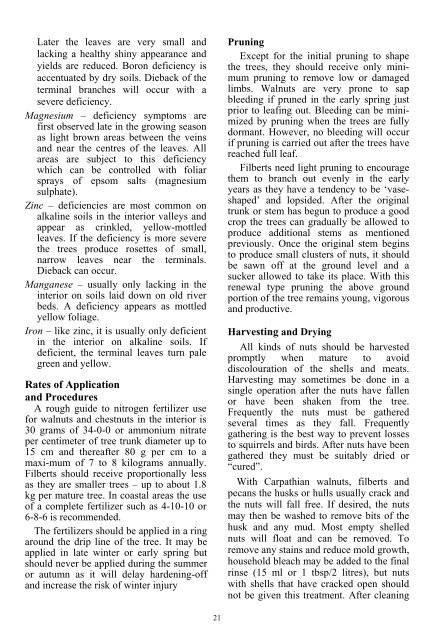Nut culture in British Columbia - Ministry of Agriculture and Lands
Nut culture in British Columbia - Ministry of Agriculture and Lands
Nut culture in British Columbia - Ministry of Agriculture and Lands
Create successful ePaper yourself
Turn your PDF publications into a flip-book with our unique Google optimized e-Paper software.
Later the leaves are very small <strong>and</strong><br />
lack<strong>in</strong>g a healthy sh<strong>in</strong>y appearance <strong>and</strong><br />
yields are reduced. Boron deficiency is<br />
accentuated by dry soils. Dieback <strong>of</strong> the<br />
term<strong>in</strong>al branches will occur with a<br />
severe deficiency.<br />
Magnesium – deficiency symptoms are<br />
first observed late <strong>in</strong> the grow<strong>in</strong>g season<br />
as light brown areas between the ve<strong>in</strong>s<br />
<strong>and</strong> near the centres <strong>of</strong> the leaves. All<br />
areas are subject to this deficiency<br />
which can be controlled with foliar<br />
sprays <strong>of</strong> epsom salts (magnesium<br />
sulphate).<br />
Z<strong>in</strong>c – deficiencies are most common on<br />
alkal<strong>in</strong>e soils <strong>in</strong> the <strong>in</strong>terior valleys <strong>and</strong><br />
appear as cr<strong>in</strong>kled, yellow-mottled<br />
leaves. If the deficiency is more severe<br />
the trees produce rosettes <strong>of</strong> small,<br />
narrow leaves near the term<strong>in</strong>als.<br />
Dieback can occur.<br />
Manganese – usually only lack<strong>in</strong>g <strong>in</strong> the<br />
<strong>in</strong>terior on soils laid down on old river<br />
beds. A deficiency appears as mottled<br />
yellow foliage.<br />
Iron – like z<strong>in</strong>c, it is usually only deficient<br />
<strong>in</strong> the <strong>in</strong>terior on alkal<strong>in</strong>e soils. If<br />
deficient, the term<strong>in</strong>al leaves turn pale<br />
green <strong>and</strong> yellow.<br />
Rates <strong>of</strong> Application<br />
<strong>and</strong> Procedures<br />
A rough guide to nitrogen fertilizer use<br />
for walnuts <strong>and</strong> chestnuts <strong>in</strong> the <strong>in</strong>terior is<br />
30 grams <strong>of</strong> 34-0-0 or ammonium nitrate<br />
per centimeter <strong>of</strong> tree trunk diameter up to<br />
15 cm <strong>and</strong> thereafter 80 g per cm to a<br />
maxi-mum <strong>of</strong> 7 to 8 kilograms annually.<br />
Filberts should receive proportionally less<br />
as they are smaller trees – up to about 1.8<br />
kg per mature tree. In coastal areas the use<br />
<strong>of</strong> a complete fertilizer such as 4-10-10 or<br />
6-8-6 is recommended.<br />
The fertilizers should be applied <strong>in</strong> a r<strong>in</strong>g<br />
around the drip l<strong>in</strong>e <strong>of</strong> the tree. It may be<br />
applied <strong>in</strong> late w<strong>in</strong>ter or early spr<strong>in</strong>g but<br />
should never be applied dur<strong>in</strong>g the summer<br />
or autumn as it will delay harden<strong>in</strong>g-<strong>of</strong>f<br />
<strong>and</strong> <strong>in</strong>crease the risk <strong>of</strong> w<strong>in</strong>ter <strong>in</strong>jury<br />
21<br />
Prun<strong>in</strong>g<br />
Except for the <strong>in</strong>itial prun<strong>in</strong>g to shape<br />
the trees, they should receive only m<strong>in</strong>imum<br />
prun<strong>in</strong>g to remove low or damaged<br />
limbs. Walnuts are very prone to sap<br />
bleed<strong>in</strong>g if pruned <strong>in</strong> the early spr<strong>in</strong>g just<br />
prior to leaf<strong>in</strong>g out. Bleed<strong>in</strong>g can be m<strong>in</strong>imized<br />
by prun<strong>in</strong>g when the trees are fully<br />
dormant. However, no bleed<strong>in</strong>g will occur<br />
if prun<strong>in</strong>g is carried out after the trees have<br />
reached full leaf.<br />
Filberts need light prun<strong>in</strong>g to encourage<br />
them to branch out evenly <strong>in</strong> the early<br />
years as they have a tendency to be ‘vaseshaped’<br />
<strong>and</strong> lopsided. After the orig<strong>in</strong>al<br />
trunk or stem has begun to produce a good<br />
crop the trees can gradually be allowed to<br />
produce additional stems as mentioned<br />
previously. Once the orig<strong>in</strong>al stem beg<strong>in</strong>s<br />
to produce small clusters <strong>of</strong> nuts, it should<br />
be sawn <strong>of</strong>f at the ground level <strong>and</strong> a<br />
sucker allowed to take its place. With this<br />
renewal type prun<strong>in</strong>g the above ground<br />
portion <strong>of</strong> the tree rema<strong>in</strong>s young, vigorous<br />
<strong>and</strong> productive.<br />
Harvest<strong>in</strong>g <strong>and</strong> Dry<strong>in</strong>g<br />
All k<strong>in</strong>ds <strong>of</strong> nuts should be harvested<br />
promptly when mature to avoid<br />
discolouration <strong>of</strong> the shells <strong>and</strong> meats.<br />
Harvest<strong>in</strong>g may sometimes be done <strong>in</strong> a<br />
s<strong>in</strong>gle operation after the nuts have fallen<br />
or have been shaken from the tree.<br />
Frequently the nuts must be gathered<br />
several times as they fall. Frequently<br />
gather<strong>in</strong>g is the best way to prevent losses<br />
to squirrels <strong>and</strong> birds. After nuts have been<br />
gathered they must be suitably dried or<br />
“cured”.<br />
With Carpathian walnuts, filberts <strong>and</strong><br />
pecans the husks or hulls usually crack <strong>and</strong><br />
the nuts will fall free. If desired, the nuts<br />
may then be washed to remove bits <strong>of</strong> the<br />
husk <strong>and</strong> any mud. Most empty shelled<br />
nuts will float <strong>and</strong> can be removed. To<br />
remove any sta<strong>in</strong>s <strong>and</strong> reduce mold growth,<br />
household bleach may be added to the f<strong>in</strong>al<br />
r<strong>in</strong>se (15 ml or 1 tbsp/2 litres), but nuts<br />
with shells that have cracked open should<br />
not be given this treatment. After clean<strong>in</strong>g

















